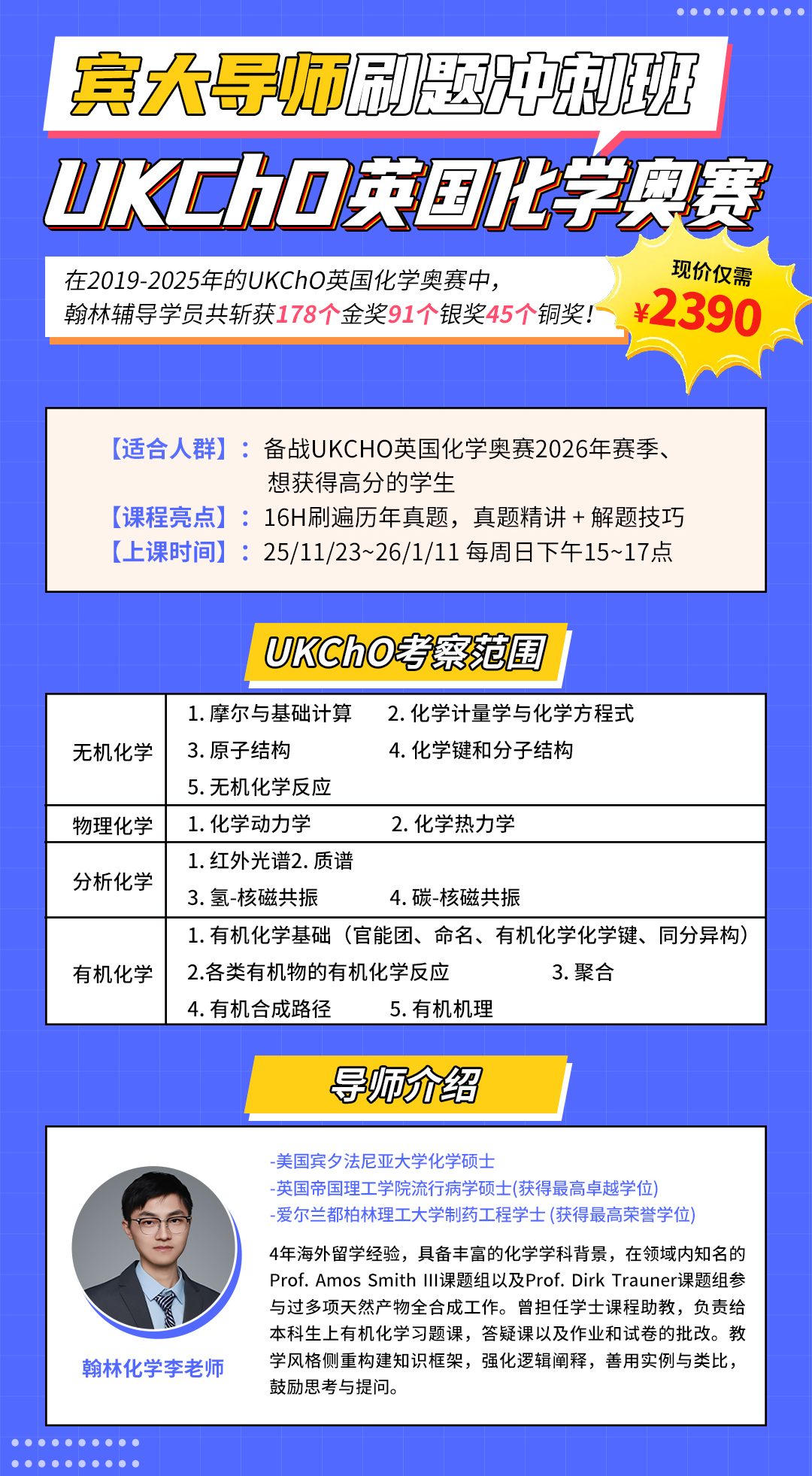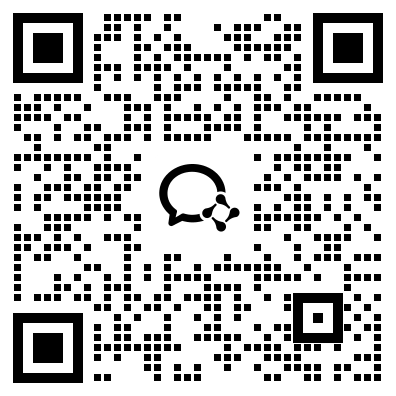我们的UKCHO辅导课程配有独家自研教材,授课老师均为海内外名校毕业,具有丰富的竞赛教学经验,并根据不同基础学生开设了不同的班课,真正做到有的放矢,事半功倍!可以试听一下~
UKCHO课程试听
需要辅导课程的同学,可以扫码咨询,然后选择符合您需求的课程进行试听~

2026最新课程⇓
宾大导师刷题冲刺班

扫码了解课程详情⇓

课程示例⇓
UKChO英国化学奥赛冲刺辅导课程(40H)
课程大纲(40H)
课程结构与进度和学生基础相关,可能会调整
General chemistry 普通化学
Crystal structure: unit cell
1. Unit cell
2. Particle number in unit cell
3. Particle distance in unit cell
4. Density of unit cell
Crystal structure: coordination & packing
1. Solving crystal questions
2. Crystal coordination number
3. Packing efficiency
4. Close packing
Covalent bond advanced
1. Valency
2. Coordinate bond
3. Formal charge
4. Calculating bond number
5. Exception of octet rule
6. Lewis structure of complex compound
Hybridisation, bond theory & coordination
1. Hybridisation
2. Bond theory
3. Resonance
4. Conjugated system
5. Coordination compound
Physical chemistry 物理化学
Kinetics advanced 1: Reaction mechanism & integrated rate law
1. Rate law
2. Reaction mechanism
3. Pre-equilibrium assumption
4. Steady state approximation
5. Integrated rate law
6. Half-life
7. Determining rate law advanced
Kinetics advanced 2: Arrhenius equation & solving kinetics question
1.Arrhenius equation
2. Solving Kinetics question
Equilibrium, acid & base
1. Arrhenius acid/base
2. Bronsted-lowry acid/base
3. Lewis acid/base
4 . pH & pOH
5. Conjugate acid/base
6. Acid/base strength
7. Ka & Kb
8. Stoichiometry advanced
Equilibrium advanced
1. Polyprotic acid
2. Buffer
3. Strong acid/base titration
4. Weak acid/base titration
5. Ksp
6. Ionic reaction
Enthalpy, entropy and Gibbs free energy
1. Spontaneity
2. Enthalpy
3. Determining ΔH
4. Entropy & probability
5. Determining ΔS
6. Gibbs free energy
7. Determining ΔG & spontaneity
Electrochemistry
1. redox reaction
2. oxidation number
3. electrode potential
4. galvanic cell
5. electrolytic cell
6. electroplating
Thermodynamics advanced: K, Ecell & ΔG
1. equilibrium constant & ΔG
2. cell potential & ΔG
3. Nernst equation
Organic chemistry 有机化学
Organic 1: hydrocarbon & double bond equivalence
1. Organic introduction
2. Hydrocarbon
3. Homologous series
4. Isomer introduction
5. Double bond equivalence (DBE)
Organic 2: representation, functional group & nomenclature
1. Structure representation
2. Functional group with O, N, S
3. Formal charge in organic
4. Resonance in organic
5. IUPAC nomenclature
Organic 3: isomerism & conformation
1. Constitutional isomer
2. Stereoisomer
3. Conformer
4. Conformational analysis
Organic 4: common organic reaction
1. Addition
2. Elimination
3. Substitution
4. Rearrangement
5. Condensation & hydrolysis
6. Oxidation & reduction
Organic 5: reaction mechanism 1, free radical synthesis
1. 4 types of mechanism
2. Free-radical synthesis pathway
3. Nucleophile
4. Electrophile
Organic 6: reaction mechanism 2, SN1, SN2, E1, E2
1. SN1, SN2 reaction
2. E1, E2 reaction
3. Electrophilic addtion
4. Polar systhesis pathway
Organic 7: addition, aromatic substitution
1. Aromaticity
2. EDG & EWG
3. Ortho/para vs meta directors
4. Synthesis involving benzene
Organic 8 :spectroscopy 1
1. Combustion analysis
2. Mass spectrum
3. DBE analysis
4. IR spectrum
5. NMR spectrum
Organic 9: spectroscopy 2 & systhesis pathway
1. Signal splitting (coupling) of NMR
2. Solving NMR question
3. Solvilng synthesis pathway
扫码了解课程详情,试听名师课程
领取课程优惠+一对一学术规划!

UKCHO英国化学奥赛冲刺辅导课程(60H)
课程结构与进度和学生基础相关,可能会调整
General chemistry 普通化学
Matter,enegy and quantities; Electromagnetic wave
1. Law of conversion of mass
2. Atoms
3. Pure substance & mixture
4. Properties
5. Four fundamental interactions
6. Law of conversion of energy
7. Kinetic energy & heat
8. Potential energy
9. Coulomb's Law
10. Electrostatic force & potential
11. Electromagnetic wave & photon
Atomic structure, nuclear chemistry & mole
1. Subatomic particles
2. Isotope
3. Element
4. Mole calculation
5. Nuclear decay
Electronic structure , periodic table arrangement & magnetism
1. Bohr model
2. Quantum mechanical model
3. Electron orbital
4. Electron configuration
5. Periodic table arrangement
6. Magnetism
7. Quantum number
Periodicity
1. Effective nuclear charge
2. Atomic radius
3. Ionic radius
4. Ionisation energy
5. Electron affinity
6. Electron negativity
Chemical bond & properties
1. Metallic bond
2. Ionic bond
3. Covalent bond
Crystal structure: unit cell
1. Unit cell
2. Particle number in unit cell
3. Particle distance in unit cell
4. Density of unit cell
Crystal structure: coordination & packing
1. Solving crystal questions
2. Crystal coordination number
3. Packing efficiency
4. Close packing
Covalent bond advanced
1. Valency
2. Coordinate bond
3. Formal charge
4. Calculating bond number
5. Exception of octet rule
6. Lewis structure of complex compound
Molecular geometry, polarity & coordination
1. Electron domain
2. VSEPR theory
3. Electron domain geometry
4. Molecular geometry
5. Molecular polarity
Hybridisation, bond theory & coordination
1. Hybridisation
2. Bond theory
3. Resonance
4. Conjugated system
5. Coordination compound
Liquid, solution& intermolecular force
1. Liquid state
2. London dispersion force
3. Dipole-dipole force
4. Hydrogen bond
5. Ion-dipole interaction
6. Solution
7. Concentration
Gas & kinetic molecular theory
1. Pressure
2. Ideal gas vs real gas
3. Ideal gas law
4. Kinetic molecular theory
5. Maxwell-Boltzmann distribution
6. Deviation from ideal gass
Physical chemistry 物理化学
Kinetics 1: rate law & collision theory
1. Factors affecting reaction rate
2. Average rate
3. Differential rate
4. Collision theory
5. Simple stoichiometry
6. Rate law
7. Determining rate law
Kinetics 2: Reaction mechanism & integrated rate law
1. Reaction mechanism
2. Pre-equilibrium assumption
3. Steady state approximation
4. Integrated rate law
5. Half-life
6. Determining rate law advanced
Kinetics 3: Arrhenius equation & solving kinetics question
1.Arrhenius equation
2. Solving Kinetics question
Equilibrium & stoichiometry
1. Reversible reaction
2. Equilibrium
3. Equilibrium constant
4. Reaction quotient
5. Le Chatelier's Principle
6. Stoichiometry advanced
Acid & base
1. Arrhenius acid/base
2. Bronsted-lowry acid/base
3. Lewis acid/base
4 . pH & pOH
5. Conjugate acid/base
6. Acid/base strength
7. Ka & Kb
Equilibrium advanced
1. Polyprotic acid
2. Buffer
3. Strong acid/base titration
4. Weak acid/base titration
5. Ksp
6. Ionic reaction
Enthalpy, entropy and Gibbs free energy
1. Spontaneity
2. Enthalpy
3. Determining ΔH
4. Entropy & probability
5. Determining ΔS
6. Gibbs free energy
7. Determining ΔG & spontaneity
Electrochemistry
1. redox reaction
2. oxidation number
3. electrode potential
4. galvanic cell
5. electrolytic cell
6. electroplating
Thermodynamics advanced: K, Ecell & ΔG
1. equilibrium constant & ΔG
2. cell potential & ΔG
3. Nernst equation
Organic chemistry 有机化学
Organic 1: hydrocarbon & double bond equivalence
1. Organic introduction
2. Hydrocarbon
3. Homologous series
4. Isomer introduction
5. Double bond equivalence (DBE)
Organic 2: representation, functional group & nomenclature
1. Structure representation
2. Functional group with O, N, S
3. Formal charge in organic
4. Resonance in organic
5. IUPAC nomenclature
Organic 3: isomerism & conformation
1. Constitutional isomer
2. Stereoisomer
3. Conformer
4. Conformational analysis
Organic 4: common organic reaction
1. Addition
2. Elimination
3. Substitution
4. Rearrangement
5. Condensation & hydrolysis
6. Oxidation & reduction
Organic 5: reaction mechanism 1, free radical synthesis
1. 4 types of mechanism
2. Free-radical synthesis pathway
3. Nucleophile
4. Electrophile
Organic 6: reaction mechanism 2, SN1, SN2, E1, E2
1. SN1, SN2 reaction
2. E1, E2 reaction
3. Electrophilic addtion
4. Polar systhesis pathway
Organic 7: addition, aromatic substitution
1. Aromaticity
2. EDG & EWG
3. Ortho/para vs meta directors
4. Synthesis involving benzene
Organic 8 :spectroscopy 1
1. Combustion analysis
2. Mass spectrum
3. DBE analysis
4. IR spectrum
5. NMR spectrum
Organic 9: spectroscopy 2 & systhesis pathway
1. Signal splitting (coupling) of NMR
2. Solving NMR question
3. Solvilng synthesis pathway
扫码了解课程详情,试听名师课程
领取课程优惠+一对一学术规划!

UKChO备赛讲义
为了让同学们更好地“消化”UKChO的知识点和解题技巧,我们精心编辑了UKChO讲义,使得同学们有教材可依!之后还会更新优化讲义,根据考情的变化来进行编写!
讲义涵盖了目前化学各个赛事重要知识点讲解,包括原子结构、分子结构与周期性、气体状态、化学计量学、动力学、热动力学、化学平衡、酸碱、电化学、固态等13个知识点。


最新版及完整版讲义,可扫码咨询~获取UKCHO竞赛资料


